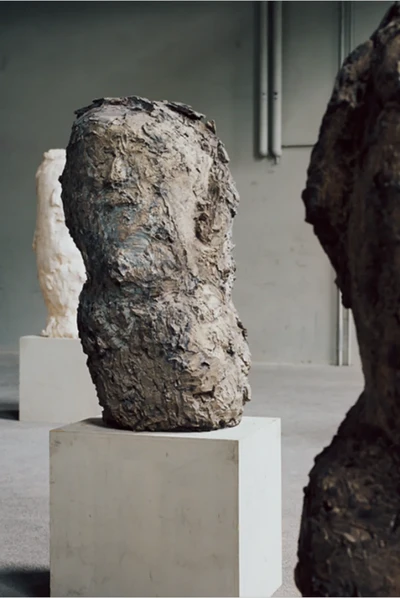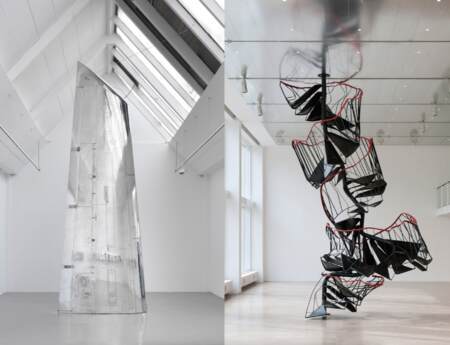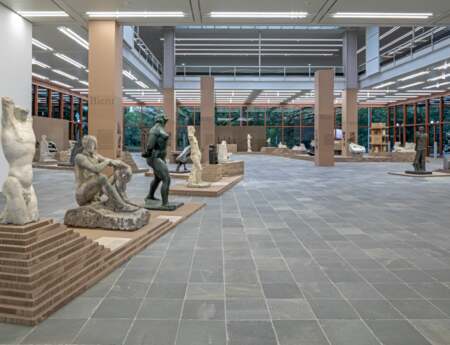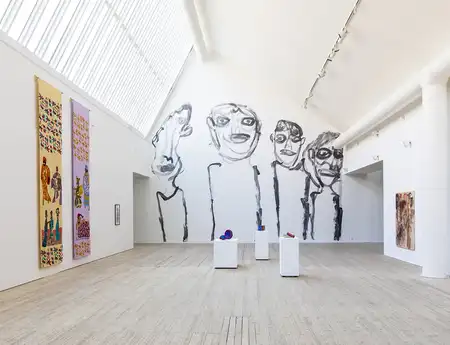Musée d'Art Moderne de Paris
11 Avenue du Président Wilson
75116 Paris
France
Josephsohn as seen by Albert Oehlen
For this first retrospective in France devoted to Swiss sculptor Hans Josephsohn (1920–2012), the Musée d'Art Moderne de Paris has entrusted the curatorship to artist Albert Oehlen, who offers a free-wheeling exploration of the artist's work. Born in 1954, Albert Oehlen is a major artist and contributor to the revival of German painting in the 1980s. An exhibition of his work was held at the Musée d'Art Moderne de Paris in 2009. A great admirer of Hans Josephsohn, Oehlen discovered his work at the Kesselhaus Josephsohn in St Gallen, in Switzerland, where he lives. Both an exhibition and conservation venue dedicated to the sculptor's work, the Kesselhaus which have provided most of the sculptures loaned for this exhibition. Out of his examination of Josephsohn's creative process – interaction with materials, the role of gesture, detail and tireless research – and its resonance with his own explorations, Oehlen draws a spirited experience of the oeuvre. Hans Josephsohn's work fascinates other artists with the sheer power of its visual language. Peter Fischli and David Weiss were among his early supporters, and in 2007 Ugo Rondinone included several of his reclining nudes in his exhibition The Third Mind, at the Palais de Tokyo.
Artist biography : The intensity of Josephsohn's work is rooted in a life tormented by history, and a vocation that would lock him into his studio for over sixty years.
Born in 1920 in Königsberg (then part of the German province of East Prussia, now Kaliningrad in Russia), Hans Josephsohn grew up in a Jewish family in the 1930s. His firsthand experience of the rise of Nazism and its attendant persecutions was a trauma that marked him for life. Attracted to sculpture from an early age, he was denied access to art school because of his origin. In 1938 he obtained a scholarship to study art in Florence, but in the autumn of that year the promulgation of Italy's racial laws forced him to flee in short order.
Arriving in Switzerland, Josephsohn settled in Zurich, where he lived until his death in 2012. Soon after his arrival, he was able to count on the support of Otto Müller (1905-1993), a Swiss sculptor who opened the doors of his studio to him. The war years were gruelling, however, involving temporary detention in a refugee camp. Sculpture remained his anchor; he moved into his first personal studio in 1943 and worked tirelessly from then on. The studio was his home ground, the place for inner dialogue with his works, the theatre for links forged and fractured with his models.
Considered in Switzerland as one of the country's most important postwar artists, he long remained unknown abroad. Thanks to a series of decisive encounters, however, the 2000s saw him beginning to make a name for himself, and in 2002 the Stedelijk Museum in Amsterdam held the first retrospective of his work outside Switzerland and Germany.
Josephsohn focused on the human – and mainly feminine – body, rendered in the form of heads, busts and standing, seated and reclining figures, often using of monumental proportions. At the same time, he modelled reliefs on varying scales, which differed from his hiera
tic figures in their narrative aspect: two and sometimes three characters embody playlets within a barely sketched architectural setting. The reliefs are reminiscent of the richness of the Romanesque sculpture, inseparable from architecture, that Josephsohn was particularly fond of.
Plaster was his favourite material, sometimes cast in bronze and more often in brass. Its malleability allowed him to develop his forms touch by touch, adding and subtracting until a point of equilibrium was reached. Josephsohn was not out to imitate reality, although certain details, especially in his early work, make it possible to identify the features of a model. His sculptures embody a presence, the essence of a being, the intensity of a moment: for him form was never the ultimate goal.
The exhibition: The chronological tour takes visitors through three stylistic periods of an artistic output oscillating between figuration and abstraction.
1950s : A simplification of forms : In the late 1940s, Josephsohn's early work was characterised by a paring-down of form and geometrisation. This period was marked by his meeting with Mirjam Abeles, who became his model in 1947 and his wife in 1954. On the postwar, scene abstraction was the dominant avant-garde mode, but Josephsohn adhered to a form of figuration, at a remove from the model, which betrayed convergences with Antiquity – funerary and symbolic Egyptian art in particular - and which recalls in its intensity the works of Alberto Giacometti.
1960-1970: The body embodied : The 1960s marked a turning point in Josephsohn's sculpture, reflected in the figures massiveness. It was also the period when his personal life changed radically: a young model, Ruth Jacob, became his partner. While this relationship found echoes in a more traditional reinvestment in the human body, his figurative work was also pursuing matter down other avenues. During this period he made no secret of his admiration for Aristide Maillol (1861-1944), although his works differed in their treatment of surfaces, the expressiveness of their modelling and a certain hieratic quality. This was a preliminary to the profound transformation that resulted in a third formal upsurge at the dawn of the 1980s.
Fom the 1980s: On the verge of abstraction : Josephsohn developed a sculptural vocabulary that he would never relinquish, digging deeper into the abstraction while retaining a few ever more distant figurative outlines. His gestural speed and virtuosity tended to inject a vibrancy into his material as his heads, busts and reclining nudes changed scale and gained in format. This renewal coincided in 1978 with the arrival in his life of his last partner and model, Verena Wunderlin. The disappearance of the figure opened up a formal field whose artists and historians indicated a proximity to elements and objects that mark our origins: geological aggregates and prehistoric Venuses.
Josephsohn as seen by Albert Oehlen : For Hans Josephsohn, as for Albert Oehlen, hands-on practice is the path to experience. Both are reluctant to get bogged down in theory, or to go hunting for meaning. As the exhibition's artistic curator, Albert Oehlen has deliberately avoided any narrative interpretation, preferring to focus on the creative process. Looking beyond the modernity of the Josephsohn oeuvre, he emphasises its contemporary heritage. At the end of the exhibition, a totemic sculpture from Oehlen's personal collection – a piece by British artist Rebecca Warren, born in 1965 – shows some formal affinities with the work of the Swiss sculptor in its treatment of the body.
Exhibition catalogue : A catalogue edited by Cornelius Tittel, editor-in-chief of Blau International, accompanies the exhibition and two films round off the tour. In support of Albert Oehlen's point of view, a series of interviews conducted by Cornelius Tittel and Felix von Boehm gives the floor to contemporary artists who are admirers of Hans Josephsohn. A historical film from 1977 by Swiss filmmaker Jürg Hassler offers a more intimate approach to the sculptor.
The exhibition has been realised in collaboration with the Kesselhaus Josephsohn in St.Gallen, Switzerland.



